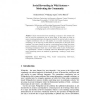HCI
2007
14 years 2 months ago
2007
This paper argues that it is important to study issues concerning trust and reliance when developing systems that are intended to augment cognition. Operators often under-rely on t...
HCI
2007
14 years 2 months ago
2007
Two unobtrusive modalities for automatic emotion recognition are discussed: speech and facial expressions. First, an overview is given of emotion recognition studies based on a com...
HCI
2007
14 years 2 months ago
2007
On Navy ships, technological developments enable crews to work more efficiently and effectively. However, in such complex, autonomous, and information-rich environments a competiti...
HCI
2007
14 years 2 months ago
2007
Abstract. One of the goals of augmented cognition is creation of adaptive human-machine collaboration that continually optimizes performance of the human-machine system. Augmented ...
HCI
2007
14 years 2 months ago
2007
Two new computational models show that the EEG distinguishes three distinct mental states ranging from alert to fatigue. State 1 indicates heightened alertness and is frequently pr...
HCI
2007
14 years 2 months ago
2007
Online communities have something in common: their success rise and fall with the participation rate of active users. In this paper we focus on social rewarding mechanisms that gen...
HCI
2007
14 years 2 months ago
2007
HCI
2007
14 years 2 months ago
2007
This paper discusses how the importance of social networks for performing everyday tasks in the developing world leads to new considerations of the utility of social networking sof...
HCI
2007
14 years 2 months ago
2007
In the VTT PLAMOS (Plant Model Services for Mobile Process Maintenance Engineer) project new tools were developed for modern maintenance work carried out in industrial plants by ei...
HCI
2007
14 years 2 months ago
2007
This paper explores how a ‘learning’ algorithm can be added to UGV’s by giving it the ability to test the terrain through ‘feeling’ using incorporated sensors, which woul...



